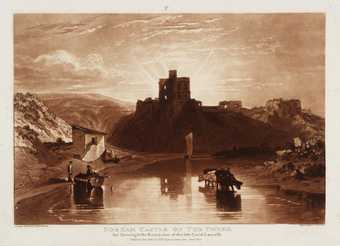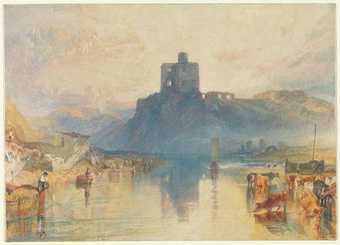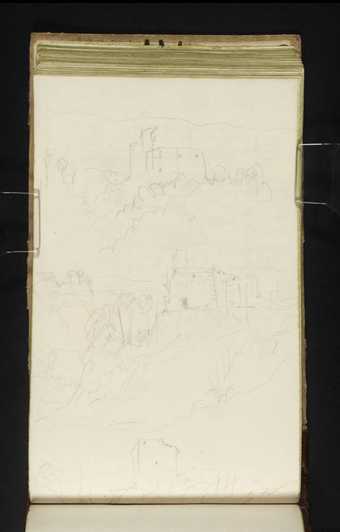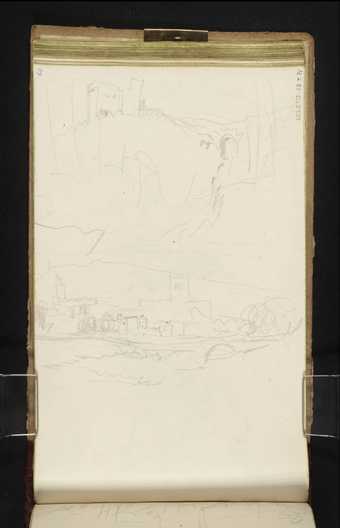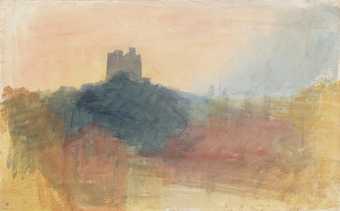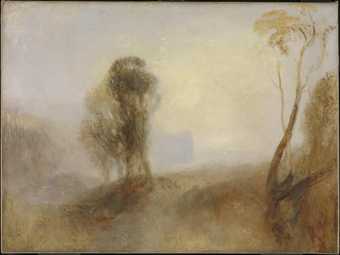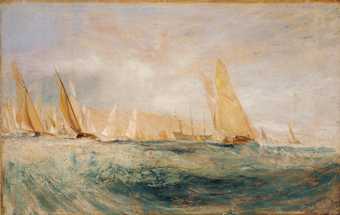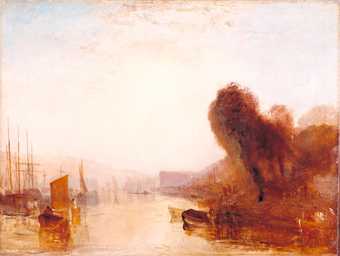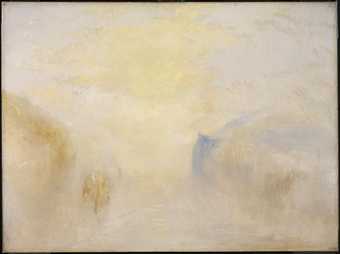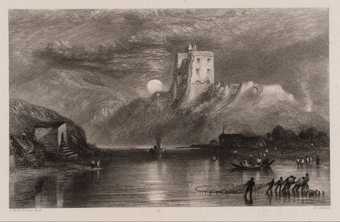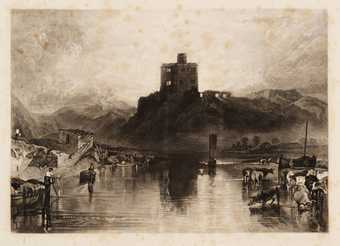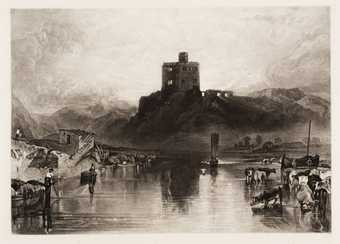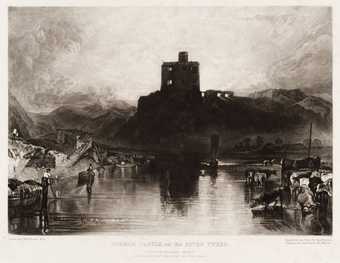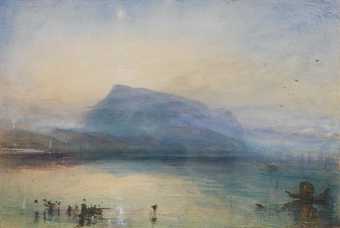
In Tate Britain
- Artist
- Joseph Mallord William Turner 1775–1851
- Medium
- Oil paint on canvas
- Dimensions
- Support: 908 × 1219 mm
frame: 1060 × 1370 × 70 mm - Collection
- Tate
- Acquisition
- Accepted by the nation as part of the Turner Bequest 1856
- Reference
- N01981
Display caption
Norham sits on the river Tweed in Northumberland, on the English side of the border with Scotland. Turner first saw Norham castle in 1797, during his first tour of northern Britain. He returned to the ruins in 1801 and 1831, creating work after each visit. Turner made this unfinished canvas late in his career. He uses colour to express the blazing light that merges the building and the landscape. It is one of a group of paintings Turner based on compositions from his ‘Liber Studiorum’ (‘Book of Studies’) (1807–19). This was Turner’s set of 70 engravings he had made from his watercolour compositions.
Gallery label, July 2020
Does this text contain inaccurate information or language that you feel we should improve or change? We would like to hear from you.
Catalogue entry
[from] Nos. 509–19: Unfinished Paintings, mainly of Liber Studiorum Subjects, c. 1840–50.
THIS group of late paintings, roughly similar in size, style, colouring and degree of finish, is remarkable in being based largely on compositions used much earlier by Turner for the Liber Studiorum. Only Sunrise, with a Boat between Headlands (No. 516 [N02002]) and Landscape with River and Distant Mountains (No. 517) seem to be entirely new inventions. In addition all but three of the remaining paintings are of subjects that Turner classified as ‘E.P.’, almost certainly ‘elevated pastoral’. Of the others, one, Norham Castle, Sunrise (No. 512 [N01981]) is a ‘P’ or ‘pastoral’ subject, Inverary Pier (No. 519) is an ‘M’ or ‘marine’ subject, while Europa and the Bull (No. 514) is based on a detail of the frontispiece, which was not given a classification. The degree of dependence on the Liber model varies. In the case of Landscape with a River and Bay in the Distance (No. 509), Chepstow Castle, which forms the main topographical motif of the Liber plate, ‘The Junction of the Severn and the Wye’, is omitted, but in two other cases, rather surprisingly, Turner makes the late oil more topographically specific than the Liber plate, Landscape with Walton Bridges (No. 511) and The Ponte delle Torri, Spoleto (No. 518 [N02424]).
All the paintings are unfinished and seem to be in the state in which Turner took such unfinished works into the Royal Academy or the British Institution before completing them on varnishing days; see in particular John Burnet's description of such unfinished pictures as being ‘divided into large masses of blue, where the water or sky was to come, and [with] the other portions laid out in broad orange yellow, falling into delicate brown where the trees and landscapes were to be placed’ (Burnet 1852, p. 100; 1859, pp. 84–5), and Rippingille's description of Turner at work on The Burning of the House of Lords and Commons at the British Institution in 1835 (see No. 359). It has, however, been suggested that these works are more than just a random selection of late unfinished pictures. Lawrence Gowing, at the Turner Symposium held at Johns Hopkins University, Baltimore in April 1975, suggested that Turner may have painted this series as a trial run to see if such ‘sketchy’ pictures were marketable. At the same symposium Jerrold Ziff suggested that, although towards the end of his life Turner appeared to become increasingly occupied with images of disaster, this group of oils, mainly of ‘elevated pastoral’ or ‘pastoral’ subjects, shows that Turner still felt that there was a place for the idyllic in the repertoire of a landscape painter and that he may have intended the group to stand as a reaffirmation of his faith in Nature in her more tranquil moods.
On the other hand, one cannot guarantee that Turner, in completing these unfinished works, might not have radically changed their mood; Frith's anecdote about Turner adding the dominant blue to Undine giving the Ring to Massaniello (see No. 424 [N00549]) shows how drastic Turner's alterations could be. Turner's last four exhibits in 1850 (Nos. 429–32 [N00552-N00555]) could all have been painted over such a lay-in as Sunrise, with a Boat between Headlands (No. 516 [N02002]). Moreover, if this group of works is as late as has sometimes been argued (see below) one has to face the fact that Turner may have been at a loss for new compositions. Of the three works he exhibited between 1847 and 1849 inclusive, one was an early work left untouched, Venus and Adonis (No. 150), while the other two were also early works, reworked for the occasion, The Hero of a Hundred Fights (No. 427 [N00551]) and The Wreck Buoy (No. 428).
Turner's use of Liber Studiorum subjects has been associated with his revival of interest in that publication; in May and June 1845 he had McQueen's run off fifteen new sets (see John Pye and J. L. Roget, Notes and Memoranda respecting the Liber Studiorum of J. M. W. Turner, 1879, p. 71 n., and Gage 1980, p. 206). In addition, it has recently been discovered that the paintings from the series now in the Tate Gallery were painted on canvases supplied by the firm of T. Brown that bear stamps of a form that does not seem to have been used before about 1839 and also, in one case, a second stamp incorporating an element that gives the year in which the canvas was made: Norham Castle, Sunrise (No. 512 [N01981]) bears an example of this second form of stamp implying the date 1844 (see Butlin, loc. cit.). This means that the dating to c. 1835–40 given in the first edition of this catalogue must be wrong and that the whole group must date from c. 1840 or later, with Norham Castle, Sunrise after 1844. In reviews of our first edition Luke Herrmann had already suggested that at least some of this group could date from the later 1840s or even to c. 1850 and Eric Shanes (1981) had suggested a dating of c. 1845, when McQueen reprinted the Liber; Andrew Wilton had also suggested that this group of oils ‘are products of Turner's last years’. More recently John Gage has also dated the group to c. 1845 (1983–4, loc. cit.), and Eric Shanes has gone further (1984), suggesting an actual order of completion beginning c. 1845 with the ‘initial delicacy and control’ of Norham Castle and Inverary Pier (Nos. 512 [N01981] and 519) and ending c. 1848, Turner's physical limitations having become acute, with ‘the somewhat rougher and clumsier handling’ of paintings such as Sunrise, a Castle on a Bay and The Ponte delle Torri, Spoleto (Nos. 515 [[N00515] and 518 [N02424]). However, if one is correct in seeing these pictures as unfinished works it is probably going too far to derive dating arguments from their precise degree of finish and subtlety.
Although four of these works remained in Turner's collection and became part of the Turner Bequest the remaining seven were dispersed, either during his lifetime or relatively soon after his death. How they left Turner's studio is a mystery. Two of the series (Nos. 511 and 513) were sold at Christie's in 1865 from the collection of John Pound, the son by her first marriage of Mrs Booth, Turner's mistress and later housekeeper in his last years at Chelsea. Turner had presumably given these pictures either to her or to her son, or they had been left in his Chelsea studio at his death and been appropriated, but none of the other pictures in the series can be shown to have come from this source. There is a possibility that they were among the approximately eighty pictures that were rejected from the Turner Bequest by the National Gallery in 1856 on the grounds that they were not genuine, but against this suggestion must be weighed both the fact that these exclusions were made by Sir Charles Eastlake, a friend of Turner's who knew his work well, and also that a number of canvases that were still less ‘finished’ than those in this series were accepted for the Bequest. Nor can these works be identified in the Schedules of 1854 and 1856, which listed all the works in Turner's possession when he died, whether by him or not. They may have simply remained as a pile of unstretched canvases, perhaps rolled up together, and have been removed from Turner's studio; Stefan Slabczynski, former Keeper of Conservation at the Tate Gallery, who cleaned No. 509 for the Louvre, reported that it had formerly been rolled up as had others of the group (see Nos. 510 and 517). A letter written by Effie Ruskin to her mother on 24 August 1852, telling her that Ruskin had renounced the executorship of Turner's will as he was sickened by all the disputes over it, continued ‘... certain it is that already Turner's lawyer has stolen a bag of drawings’, which makes it sound as if the studio was open to pilfering of this kind. (Incidentally, had the late codicil to Turner's will that restricted the works that were to go to the nation to his ‘finished pictures’ not been set aside, none of this group, nor any other of Turner's unfinished pictures, would have formed part of the Turner Bequest.)
Lit. Rothenstein and Butlin 1964, pp. 62–4; Gage 1975, pp. 454–6; Herrmann 1978, p. 773; Wilton 1979, pp. 224, 247; Butlin 1981, pp. 43–5; Shanes 1981, pp. 45–6; Gage in exh. cat., Paris 1983–4, pp. 149–51; Shanes 1984, pp. 284–8.
512. [N01981] Norham Castle, Sunrise c. 1845–50
THE TATE GALLERY, LONDON (1981)
Canvas, 35 3/4 × 48 (91 × 122)
Coll. Turner Bequest 1856; transferred to the Tate Gallery 1914.
Exh. Paris 1938 (145); New York, Chicago and Toronto 1946–7 (54, pl. 46); Amsterdam, Berne, Paris, Brussels, Liege (34), Venice and Rome (39) 1947–8; Paris 1953 (82); New York, St. Louis and San Francisco 1956–7 (112, pl. 13); Tate Gallery 1959 (354); R.A. 1974–5 (650, repr. in colour p. 184).
Lit. MacColl 1920, p. 29; Clark 1949, p. 107, pl. 87; Rothenstein 1949, p. 24, colour pl. 2; Clare 1951, p. 102; Herrmann 1963, p. 38; Rothenstein and Butlin 1964, pp. 50, 62–4, pl. 124; Lindsay 1966, p. 203; Gage 1969, pp. 40–41, 126, 254 n. 250, pl. 35; Holcomb 1974, p. 47, pl. 10; Andrew Wilton, ‘Retrospect: Norham Castle 1798–1840’ in exh. cat., R.A. 1974–5, pp. 172–4, repr. in colour p. 184; Herrmann 1975, pp. 54, 234–5, colour pl. 177; Wilton 1979, p. 224; Butlin 1981, p. 45, repr.; Hawes 1982, pp. 42–4; Shanes 1984, p. 287.
This is one of the examples of a later development of a plate from the Liber Studiorum, in this case published on 1 January 1816 under the catagory ‘P’ for ‘Pastoral’ (R. 57, repr. Finberg 1924, p. 227 and Herrmann 1975, pl. 188; the preliminary pen and sepia drawing, CXVIII-D, repr. Finberg 1924, p. 226 and Herrmann 1975, pl. 187, and the underlying etching repr. Finberg 1924, p. 226). The plate is inscribed as being from ‘the Drawing in the Possession of the late Lord Lascells’, the watercolour from the Harewood Collection that is one of two closely related compositions, one of which was exhibited at the R.A. in 1798 as ‘Norham Castle on the Tweed, Summer's Morn’ with a quotation from Thomson's Seasons (both versions are in private collections, one ex. Laundy Walters, the other ex. Mrs Thwaites; the first repr. Armstrong 1902, pl. 16 and Gage op. cit., pl. 33, the second exh. R.A. 1974–5 (640)). Two large watercolour studies for the 1798 exhibit are in the British Museum (L-B and C, the first repr. Herrmann 1975, pl. 186). Turner had sketched this view in 1797 in his ‘North of England’ sketchbook (XXXIV-57, repr. Herrmann 1975, pl. 184) and again in his ‘Helmsley’ sketchbook on his way to Scotland in 1801 (LIII-42 verso-50, especially 44 verso and 45, repr. Herrmann 1975, pl. 185).
In its turn the somewhat revised Liber composition led on to a number of later versions. A finished watercolour in the British Museum (Turner Bequest CCVIII-O; repr. Rawlinson and Finberg 1909, colour pl. 14, Gage 1969, pl. 34 and Herrmann 1975, pl. 189) formed the basis for two further engravings, one done by Charles Turner in 1824 for the Rivers of England Part ii, pl. 1 (repr. Herrmann 1975, pl. 190), the other by Percy Heath in 1827, perhaps for the Literary Souvenir. A further engraving, done by William Miller in 1834 for Scott's Provincial Antiquities of Scotland, was based on new on-the-spot pencil sketches made in the ‘Abbotsford’ sketchbook in 1831 (CCLXVII-59 verso) and on another finished watercolour formerly in the collection of Munro of Novar and now in the United States. Armstrong lists three further finished watercolours, dating them 1800–02, c. 1820 and 1820–25 (op. cit., p. 268; see also Wilton 1979, nos. 225–6, 277, 736, 1052, 1099).
Of two colour beginnings in the British Museum, one (CCLXIII-22) probably dates from c. 1817 while the other (CCLXIII-72) may date from as late as the oil painting. Nevertheless, the oil is closer in general composition and in the presence of cattle in the water to the Liber plate. The mass of the castle is however assimilated with the central bluff rather than standing above it silhouetted against the sky, and the other forms, including the barely-sensed hut on the left, are much more impressionistically defined. (For Turner's preoccupation with this subject, and its development, see in particular Wilton, 1974–5.)
The canvas of this picture bears not only a Thomas Brown stamp in the form used from about 1839 but also a second stamp that seems to include the date [18] 44 (see Butlin, loc. cit.). Despite the thin, watercolour-like appearance, the paint was partly worked with the end of the brush (or perhaps Turner's thumb-nail) and also bears fingerprints, presumably his.
Published in:
Martin Butlin and Evelyn Joll, The Paintings of J.M.W. Turner, revised ed., New Haven and London 1984
Explore
- architecture(30,960)
- formal qualities(12,454)
- UK cities, towns and villages(12,725)
- Northumberland(210)
- England(19,202)
- England, North East(674)
- England, Northern(2,975)
- River Tweed(107)
You might like
-
Joseph Mallord William Turner Norham Castle on the Tweed, engraved by Charles Turner
1816 -
Joseph Mallord William Turner Norham Castle, on the River Tweed
c.1822–3 -
Joseph Mallord William Turner Three Sketches of Norham Castle
1831 -
Joseph Mallord William Turner Norham Castle; and Jedburgh Abbey
1831 -
Joseph Mallord William Turner Norham Castle at Sunrise
c.1830 -
Joseph Mallord William Turner Sunrise, a Castle on a Bay: ‘Solitude’
c.1840–5 -
Joseph Mallord William Turner Sunrise with Sea Monsters
c.1845 -
Joseph Mallord William Turner Sketch for ‘East Cowes Castle, the Regatta Beating to Windward’ No. 3
1827 -
Joseph Mallord William Turner Sketch for ‘East Cowes Castle, the Regatta Starting for Their Moorings’ No. 1
1827 -
Joseph Mallord William Turner Sunrise, with a Boat between Headlands
c.1840–5 -
After Joseph Mallord William Turner Norham Castle - Moonrise
1834–6 -
After Joseph Mallord William Turner Norham Castle, on the River Tweed
1824 -
After Joseph Mallord William Turner Norham Castle, on the River Tweed, engraved by C. Turner
1824 -
After Joseph Mallord William Turner Norham Castle, on the River Tweed, engraved by Charles Turner
1824 -
Joseph Mallord William Turner The Blue Rigi, Sunrise
1842

